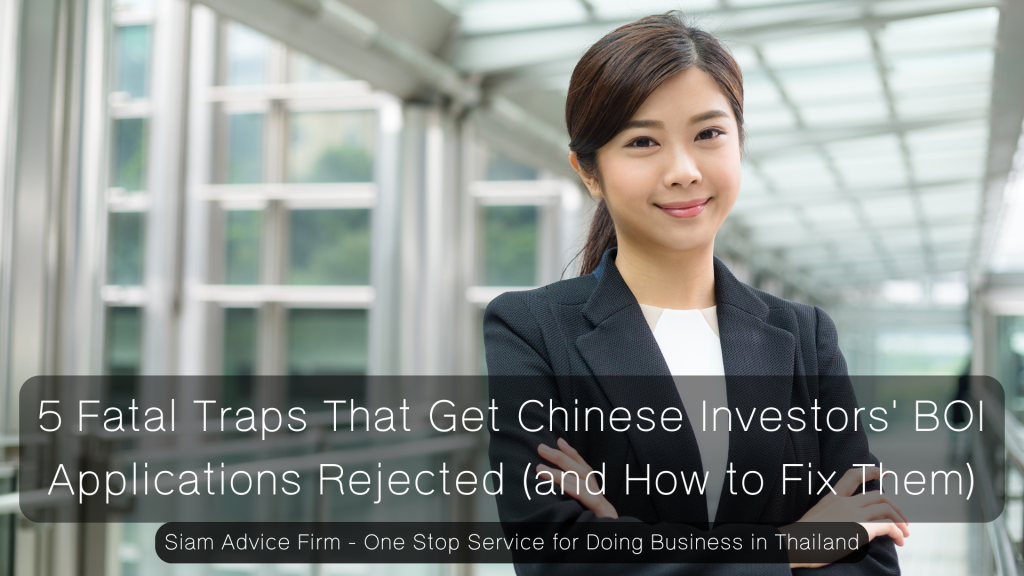
You have spent months preparing your business plan. You have committed significant capital and resources, fueled by a powerful vision for your company’s future in Thailand. Then, the letter arrives: your application for promotion by the Thailand Board of Investment (BOI) has not been approved. It is every investor’s nightmare. But fortunately, it is an avoidable one.
From direct experience advising hundreds of Chinese enterprises, we have identified the five most common and fatal traps that cause promising projects to fail at this critical stage. This guide is not just a list of problems; it is the strategic vaccine that will protect your investment. By understanding these pitfalls, you can transform your application from a gamble into a calculated step towards success.
Trap #1: The Business Plan That Fails to Tell a Story
The Problem: Many applications are submitted with a business plan that is merely a direct translation of raw company data. It states facts but lacks a strategic narrative that connects the project to the specific, long-term economic goals of Thailand.
The Expert Insight: The BOI committee is not just reading numbers; they are looking for a compelling story of mutual benefit. They need to see that you understand the country’s strategic direction—such as the Thailand 4.0 policy or the Bio-Circular-Green (BCG) Economy model—and how your investment will actively help drive those objectives forward. An application is not a form to be filled; it is a proposal to be sold.
The Solution (Actionable Advice): Use this “Benefit to Thailand” checklist to review your plan:
- Local Employment: Have you clearly stated how many Thai citizens you will employ and in what roles?
- Technology Transfer: What specific skills, processes, or technologies will be transferred to the local workforce?
- Supply Chain Integration: What percentage of your raw materials will be sourced from within Thailand, supporting local businesses?
Trap #2: Unsubstantiated Investment Figures
The Problem: The investment budget presented appears inconsistent with the project’s scale—either too high or too low—and lacks credible documentation to support the figures for machinery, construction, and other capital expenditures.
The Expert Insight: BOI officials are industry specialists with access to benchmark data for machinery costs and operational expenses. Unrealistic or unjustifiable figures are the biggest red flag for an application. It immediately undermines the project’s credibility and suggests a lack of professional diligence.
The Solution (Actionable Advice):
- Always support high-value investment items, like machinery, with official price quotations from suppliers.
- Clearly separate and justify your Working Capital calculations, explaining the basis for your projections (e.g., three months of operational expenses). This demonstrates thorough financial planning.
Trap #3: The Unprepared Interview
The Problem: The representative sent for the crucial BOI interview—often an executive from the parent company—is unable to answer detailed, practical questions about the planned operations in Thailand.
The Expert Insight: The interview is not a formality; it is a critical feasibility test. The officials need to speak with the person who truly understands the operational plan on the ground. They are testing the project’s seriousness and viability, and a representative who cannot answer specifics signals a high-risk investment.
The Solution (Actionable Advice): Prepare your representative to answer the “Top 5 Killer Interview Questions” that are almost always asked:
- How will you acquire your first customers in the Thai market?
- Who are your primary local suppliers for raw materials?
- What is your training and development plan for your Thai employees?
- How does this project fit into the broader ASEAN market strategy?
- What are the key challenges you anticipate in the first year of operation?
Trap #4: Choosing the Wrong BOI Category
The Problem: An investor selects a single BOI category that covers their main business activity but overlooks secondary activities like research and development, post-sales support, or logistics, thereby missing out on significant additional incentives.
The Expert Insight: Think of the list of BOI-promoted activities like a university course catalog. You can, and should, enroll in multiple “classes” to maximize your “credits” (incentives). A single project can often qualify for benefits under several categories simultaneously.
The Solution (Actionable Advice):
- Unbundle every distinct activity your business will perform—from manufacturing and R&D to distribution and technical support.
- Match each of these individual activities against the BOI’s list. For example, an electric vehicle manufacturer could potentially apply for promotion under “Electric Vehicle Manufacturing,” “EV Battery Production,” “Charging Station Services,” and “Research & Development” all within the same master project.
Trap #5: Ignoring Post-Approval Conditions
The Problem: A common and dangerous misconception is that the process is finished once the BOI approval letter is received.
The Expert Insight: A BOI promotion is a “permit to start,” not a graduation certificate. It comes with strict ongoing conditions that must be met to retain the benefits. Failure to comply with requirements—such as importing machinery within a set timeframe, submitting progress reports, or meeting employment quotas—can lead to the full revocation of all privileges.
The Solution (Actionable Advice):
- Treat the approval as the beginning of the compliance journey.
- Immediately create a “Post-BOI Compliance Checklist” that includes key deadlines for issuing the promotion certificate, reporting project progress, and submitting requests for specific duty exemptions.
Conclusion: Turning Risk into a Strategic Advantage
The key to avoiding these five fatal traps is a single, powerful principle: deep preparation through the lens of Thailand’s strategic priorities. By shifting your perspective from simply “what do I want?” to “what value can I bring?”, you transform the application process from a bureaucratic hurdle into your first strategic victory in the market.
Now that you understand the traps to avoid, the next step is to understand the entire path to success. Read our Complete Guide to BOI Promotion to see the full picture.
Need an expert to review your plan and ensure you avoid these pitfalls? Contact us for an initial project assessment.